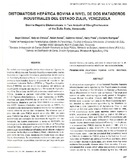| dc.rights.license | http://creativecommons.org/licenses/by-nc-sa/3.0/ve/ | |
| dc.contributor.author | Chirinos, Angel R. | |
| dc.contributor.author | Martínez de Chirinos, Nelly S. | |
| dc.contributor.author | Román Bravo, Rafael | |
| dc.contributor.author | Hómez, Guillermo | |
| dc.contributor.author | Pirela, Henry | |
| dc.contributor.author | Rodríguez, Norberto | |
| dc.date.accessioned | 2009-03-20T20:31:54Z | |
| dc.date.available | 2009-03-20T20:31:54Z | |
| dc.date.issued | 2009-03-20T20:31:54Z | |
| dc.identifier.issn | 0798-2259 | |
| dc.identifier.uri | http://www.saber.ula.ve/handle/123456789/27370 | |
| dc.description.abstract | Se realizó una investigación de los decomisos de hígados de bovinos infectados con Fasciola hepática y reportados por los Servicios de Inspección Veterinaria postmortem del Ministerio de Sanidad y Asistencia Social. La procedencia y volumen de animales beneficiados durante el período de estudio en los matadores Industrial Bolívar (FIBCA) y Frigorífico Industrial Mara (FIMARA), se obtuvo de los registros del servicio de clasificación de carne que mantiene el Ministerio de Agricultura y Cría. De un total de 631.509 animales beneficiados en el FIBCA durante el período 1984-1998 fueron reportados 2.113 hígados distomatósicos, lo que representa un 0,33%, mientras que para FIMARA de un total de 131.556 bovinos sacrificados, durante el período 1992-1998 fueran decomisados 8.070 hígados infectados, representando un 6,13%. La prevalencia de distomatosis hepática bovina fue de comportamiento diferente en los dos mataderos. Se observa que el pico más alto para FIBCA ocurrió en el año 1991, en tanto cara FIMARA fue el año 1992. Se determinaron las pérdidas económicas por concepto de decomisos de hígados con distomatosis, las cuales alcanzaron la suma de $127.025. Se concluye que la alta prevalencia encontrada en el Frigorífico Industrial Mara, en relación al Frigorífico Industrial Bolívar se debe a que los animales beneficiados en el referido matadero provienen de los Municipios Mara y Páez, ubicados en la región del Edo. Zulia, donde existe desde hace tres décadas a distomatosis. Se recomienda realizar estudios que permitan cuantificar las pérdidas económicas por baja en la producción láctea y de carne, así como lo relacionado con la eficiencia reproductiva de los rebaños en las zonas afectadas. | es_VE |
| dc.rights | info:eu-repo/semantics/openAccess | |
| dc.subject | Distomatosis hepática | es_VE |
| dc.subject | Bovino | es_VE |
| dc.subject | Decomisos | es_VE |
| dc.subject | Prevalencia | es_VE |
| dc.title | Distomatosis hepática bovina a nivel de dos mataderos industriales del estado Zulia, Venezuela | es_VE |
| dc.title.alternative | Bovine hepatic distomatosis in two industrial slaugtherhouses of the Zulia state, Venezuela | es_VE |
| dc.type | info:eu-repo/semantics/article | |
| dc.description.abstract1 | A retrospective investigation of confiscated Fasciola hepatica infected bovina livers reported by the Post-Mortem Veterinary Inspection Services of the Ministerio de Sanidad y Asistencia Social (Department of Health) was carried out. The origin and number of cattle killed during the study period in Slaughterhouses Bolivar Industrial (FIBCA) and Mara Industrial (FIMARA) were obtained from data at the Meat Classifying Service, directed by veterinarians appointed by the Ministerio de Agricultura y Cria (Department of Agriculture). From a total number of 631.509 cattle killed at FIBCA from 1984 lo 1998, 2.113 distomatosis livers were reported, which represents 0.33%, meanwhile at (FIMARA), from a total of 131.556 animals killed between 1992 and 1998, 8.070 infected livers with a prevalence of 6.13% were confiscated. The prevalence of hepatic bovine distomatosis behaved differently in both places. It is observed that FIBCA reached its peak in 1991, and FIMARA reached it in 1992. $127.025 is the amount of money that represents the economic losses, due to the confiscation of distomatosis livers. It can be concluded that prevalence found at FIMARA in relation lo FIBCA is due to the fact that the animals killed at FIMARA are animals from Paez and Mara, which are northern districts in Zulia state, and where there has been evidence this parasitic disease since three decades. It is recommended that studies which allow assessment of economic losses caused by this parasitic disease by the low milk and meat production, as well as aspects regarding reproductive efficiency of cattle in the affected area be conducted. | es_VE |
| dc.description.colacion | 297 - 302 | es_VE |
| dc.description.frecuencia | Bimestral | |
| dc.identifier.depositolegal | 199102ZU46 | |
| dc.subject.institucion | Universidad del Zulia (LUZ) | es_VE |
| dc.subject.institucion | Universidad de Los Andes (ULA) | es_VE |
| dc.subject.keywords | Hepatic distomatosis | es_VE |
| dc.subject.keywords | Bovine | es_VE |
| dc.subject.keywords | Prevalence | es_VE |
| dc.subject.keywords | Confiscations. | es_VE |
| dc.subject.publicacionelectronica | Revista Científica | |
| dc.subject.tipo | Revistas | es_VE |
| dc.type.media | Texto | es_VE |



